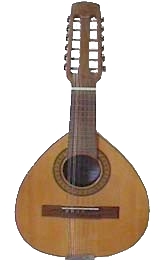
Bandurria
The bandurria is a plucked chordophone from Spain, similar to the mandolin and bandola, primarily used in Spanish folk music, but also found in former Spanish colonies.
Prior to the 18th century, the bandurria had a round back, similar or related to the mandore.[1] It had become a flat-backed instrument by the 18th century, with five double courses of strings, tuned in fourths.[1] The original bandurrias of the Medieval period had three strings. During the Renaissance they gained a fourth string. During the Baroque period the bandurria had 10 strings (5 pairs).
The modern bandurria has 12 strings (6 pairs). The strings are tuned in unison pairs, going up in fourths from the low G#. The lowest four strings are a major-third above those of a standard guitar and the highest two strings are a fourth above a standard guitar, i.e. G♯, c♯, f♯, b, e and a.[2]



